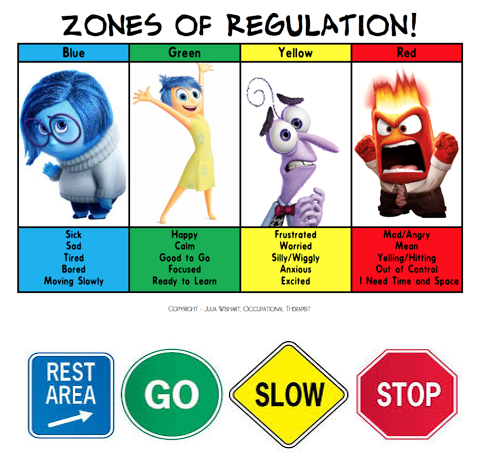Zones of Regulation
The Zones of Regulation is a framework based around the four colours to support children's self-regulation and emotional control. From time-to-time we all come across circumstances when we are less regulated. The concept behind the zones, teach the children to recognise when they are becoming less regulated, how to mange those feelings and move to a healthy place. We teach the skills of self-regulation and practice these skills to develop our children's independence to control their behaviour. The framework helps children identify their emotions, their triggers and develop problem-solving skills by drawing upon their own bank of strategies to manage their emotions. In addition children will learn to read facial expressions and promotes open discussions about our mental health.
Our approach to emotional wellbeing is consistent across the school, as we have a common language with which to discuss their emotions and how to regulate their feelings. Within 'The Zones of Regulation', there is a progression of skills and vocabularly as the children move up through the school: In Reception, the children focus on identifying their emotions. In Upper Key Stage 2 the children will discuss how their actions and behaviour can impact on those around them.
How Does it Work?
The four coloured zones categorises how we feel, into four different states of alertness. Children learn to recognise their feelings and learn what tools will help them to manage their state of alertness and emotions, considering the environment and the people around them.
Different zones might be useful for different situations - you might feel it is beneficial to have a higher state of alertness (the 'yellow' zone) when playing in a dodgeball competition on the playground, whereas to feel sleepy is useful for bedtime (the 'blue' zone) and to feel focused and calm is best when learning in a small group in the classroom (the green zone). It is important to note that no zone is seen as bad and noone would be in trouble for feeling an emotion in the 'red' zone, however when a child feels uncomfortable in a particular zone, they should be encouraged to recognise this and draw upon their toolbox of ideas to regulate themselves. Each of our classrooms have an emotional wellbeing display to support their learning of 'The Zones of Regulation'.

What are the four zones?
The Blue Zone: needing to re-charge/rest, a low level of alertness. Feeling low and running slow. You might feel unhappy, tired, tearful or withdrawn.
The Green Zone: ready to go and focused, a calm state of alertness. You might feel calm, happy, positive or proud.
The Yellow Zone: caution - feeling a little wobbly, a heightened state of alertness. You might feel excited, frustrated, worried, excited or silly.
The Red Zone: stop - a heightened state of alertness and intense feelings of emotions. You might feel angry, terrified, aggressive or out of control.
How can you help at home?
- Identify your own feelings using Zones language in front of your child (e.g.: I’m frustrated. I think I am in the Yellow Zone.”)
- Talk about what tool you will use to be in the appropriate Zone (e.g.: “I need to take four deep breaths to help get me back to the Green Zone.”)
- Empathise with your child and validate what they are feeling.
- Engage your child in discussion around Zones when they are in the Red Zone is unlikely to be effective. You need to be discussing the different Zones and tools they can use when they are more regulated / calm.
- Teach your child which tools they can you. (eg: “It’s time for bed. Let’s read a book together in the comfy chair to get you in the Blue Zone.”)
- Regular Check-ins. “How are you feeling now?” and “How can you get back to Green?”
- Modelling It is important to remember to show the children how you use tools to get back to the green zones. You might say “I am going to make myself a cup of tea and do some breathing exercises because I am in the blue zone” and afterwards tell your child how using those tools helped you get back to the green zone.
- Share how their behaviour is affecting your Zone. For example, if they are in the Green Zone, you could comment that their behaviour is also helping you feel happy / go into the Green Zone.
- Put up and reference the Zones visuals and tools in your home.
- Praise and encourage your child when they share which Zone they are in.
- Explore what helps your child feel calmer. Some children find colouring, play dough, using stress balls, time at the park, listening to music or reading really beneficial.
- Exercise is a good way to feel more motivated and increase your state of alertness - this could be a walk, yoga, football or tennis.
Want to Find Out More?
